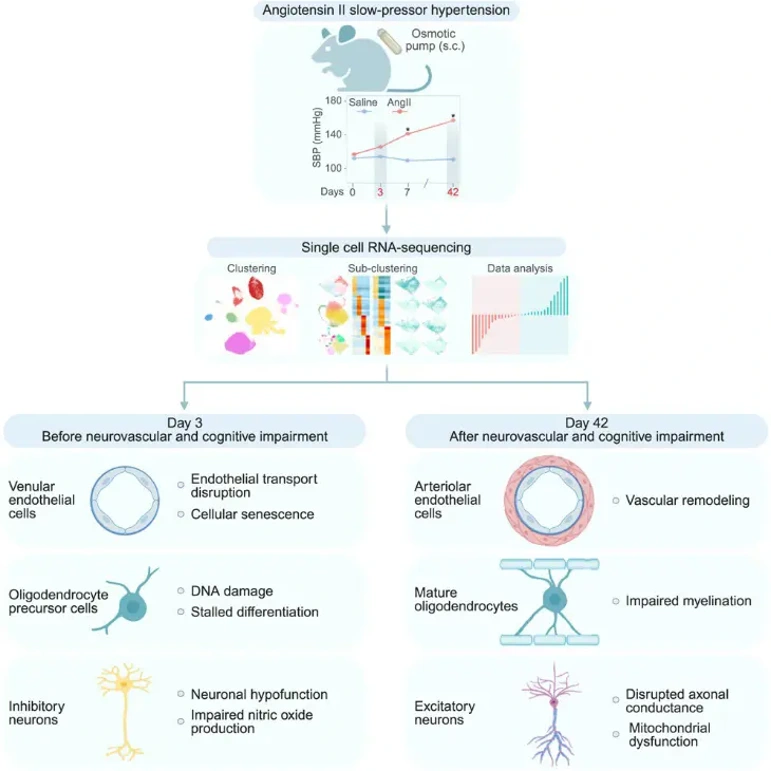Brain SOS: The Hidden Start of Hypertension
Did you know that over 1 billion people worldwide suffer from hypertension? Even more alarming is that people with hypertension have a 1.2 to 1.5 times higher risk of developing cognitive impairment (such as vascular dementia and Alzheimer's disease) than healthy individuals. While antihypertensive drugs effectively control blood pressure, they often fail to prevent the subtle decline in brain function. What is the hidden mechanism behind this "invisible attack"?
Recently, a report published in Neuron, titled "Hypertension-induced neurovascular and cognitive dysfunction at single-cell resolution" sheds light on this mystery. Researchers discovered that hypertension's "sneak attack" on the brain begins long before blood pressure rises; in the article, scientists used single-cell sequencing technology to capture, for the first time, the "distress signals" of brain cells in the early stages of hypertension.
In a mouse model of hypertension induced by angiotensin II, a peptide involved in human hypertension, scientists mapped neocortical transcriptomic changes before (3 days) and after (42 days) onset of neurovascular and cognitive deficits.
Day 3: Three types of cells were affected: 1) Endothelial cells: premature aging, decreased energy metabolism, and weakened blood-brain barrier function; 2) Interneurons: dysfunction, imbalance between excitation and inhibition signals in the brain; 3) Oligodendrocytes: blocked expression of myelin maintenance genes, and a critical shortage of the neurotransmission "insulation layer".
Day 42: Cognitive impairment appeared, accompanied by myelin damage, axonal conduction abnormalities, and neuronal mitochondrial dysfunction.

Researchers emphasized that these changes were not directly caused by elevated blood pressure, but rather by the angiotensin II signaling pathway; this means that hypertension damages the brain insidiously at the molecular level.
How Does This "Hidden Crisis" of The Brain Occur?
Endothelial cells are the "guardians" of the inner vascular lining. Researchers have found that in the early stages of hypertension, these cells already exhibited slowed metabolism, accelerated aging, and even cessation of cell division. This weakens the blood-brain barrier, causing the brain's "security system" to malfunction and potentially allowing harmful substances to enter.
Interneurons are responsible for regulating the "traffic lights" of nerve signals. Once their function is impaired, the balance between excitatory and inhibitory signals in the brain becomes unbalanced, much like urban traffic chaos. This imbalance is also common in Alzheimer's disease and may be a key link between hypertension and cognitive impairment.
The myelin sheath is the "insulating outer layer" of nerve fibers, ensuring high-speed signal transmission. Researchers indicate that in the early stages of hypertension, oligodendrocytes become "neglectful," no longer effectively expressing genes essential for myelin maintenance. Over time, this leads to a "leakage and short-circuiting" in neural signal transmission, naturally resulting in declining cognitive function.
A Glimmer of Hope: Can Antihypertensive Drugs Also Protect the Brain?
In the study, researchers administered the commonly used antihypertensive drug losartan to the mouse models. They found that it could reverse early damage to endothelial cells and interneurons. This suggests that drugs targeting the angiotensin pathway might not only lower blood pressure but also directly protect the brain! As Dr. Iadecola, the lead researcher, stated, "Hypertension is a major cause of heart and kidney damage, and controlling blood pressure is crucial; but if we can simultaneously block its early damage to the brain, it will be a major step forward in cognitive protection."
From "Lowering Blood Pressure" to "Protecting the Brain": Precision Medicine
The next step for researchers is to delve deeper into how hypertension triggers premature aging of small blood vessels and subsequently impairs neuronal and myelin function. As the mechanisms become clearer, researchers may be able to develop a precision therapy that combines "lowering blood pressure + protecting the brain," alleviating the anxieties of hypertensive patients.
Creative Bioarray is the leading preclinical CRO specializing in animal models of hypertension. We have a wide range of transgenic and inducible mouse and rat models readily available for your studies. Our team of animal model scientists will work with you to find the right model.
Learn more about our fully characterized and validated animal models for hypertension.
Reference:
- Schaeffer, Samantha M., et al. "Hypertension-induced neurovascular and cognitive dysfunction at single-cell resolution." Neuron (2025).

Your email address will not be published. Required fields are marked *